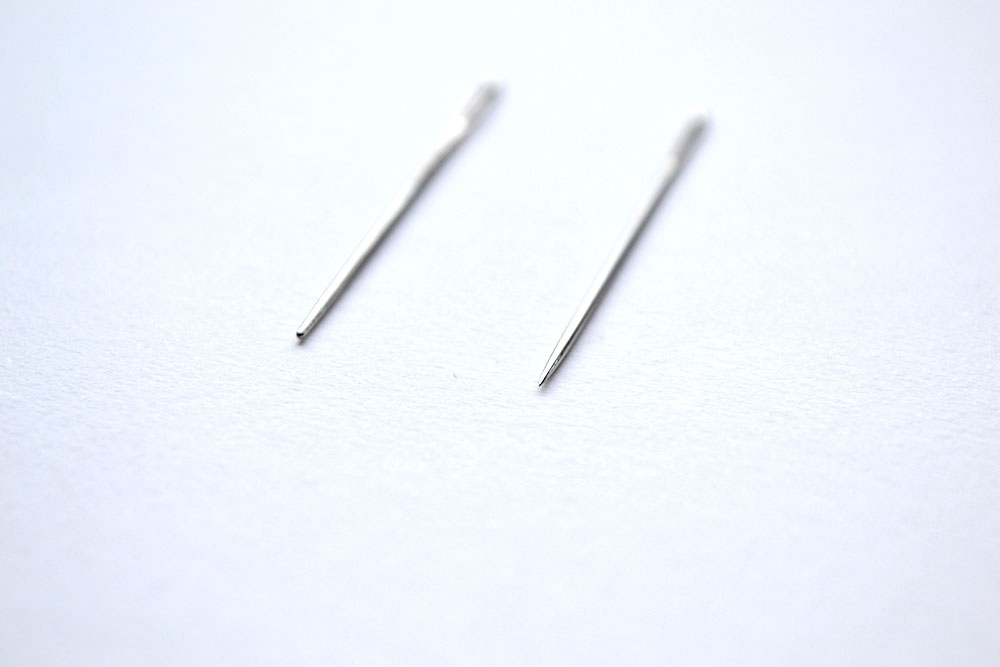Tools are one of the most important things in any craft. Embroidery is no exception! Using the right embroidery tools for the project is key and so is quality. You don’t have to use the
Regarding tools, embroidery is a very minimalistic craft. All you really need is a needle and something to cut your thread. Using an embroidery hoop or frame is optional, but I highly recommend using one when you are just starting out.
Get even more embroidery tips for beginners in the comprehensive beginner guide.
Disclaimer: This article contains affiliate links.

EMBROIDERY TOOL KIT
If you are unsure which tools to get, this embroidery tool kit is for you. It has all the things you need for embroidery and comes with a sampler pattern to try out, too!
✂️ Check out this embroidery starter kit over on Etsy.
Most important embroidery tools: needles
First, ditch the old rusty sewing needles you have found in the attic. It took me years of cursing before I bought a new set of needles, and I never looked back at my old ones after that.
Do yourself a favor and get a set of embroidery needles in various sizes. There are quite a couple of sets out there. One for pointy and one for blunt tips got you covered for many years and projects to come. They don’t cost the world, and you can test out which ones you like to work with best.

Pointy vs blunt
Pointy tips are useful when you have to pierce the fabric. For regular surface embroidery, pointy needles are commonly used.
Blunt tips are useful when you want to slide between the threads of the fabric or other stitches without splitting them. Blunt needles are commonly used for counted embroidery like cross stitch or for weaving techniques.
Here are two needle sets, suitable for embroidery on Etsy

The embroidery hoop
There are a lot of different embroidery hoops out there. The most common ones are wooden hoops. I find them very easy to use as a beginner and you can get them in a huge range of sizes.
Quality, quality, quality
Don’t get the cheap stuff that costs below a dollar. Especially for a beginner, it’s frustrating and more difficult to work with a low-quality embroidery hoop.

You can identify a good hoop if it’s meeting these criteria:
- The closure looks sturdy and closes tightly
- hardwood like beech indicates a better quality hoop than birch or bamboo
- no gaps between the inner and outer ring
- no splintering
Embroidery hoops by DMC, Anchor and Hardwicke Manor are very good quality and I personally use them. On Etsy, you can find a huge variety of good embroidery hoops.
Which size is best?
A size between 6 and 8 inches in diameter is the most comfortable to use. If you can’t decide, take a 6-inch hoop.
If you want to do smaller embroidery or embroider clothes get a 4-inch/10 cm hoop, too.
Bonus: Do you need more information on embroidery hoops? Make sure to look into the Who is Who of hoops article, too.

Scissors
Fabric scissors
If you have tried cutting fabric with normal craft or household scissors you might have noticed that it’s not a pleasant experience. Fabric scissors are specifically made for fabric and you should use them for fabric only or they will become blunt quickly.
Thread snips/cutters/scissors
A pair of very sharp and pointy scissors is a huge help when it comes to ripping out stitches and cutting threads close to the fabric. They are available in a huge variety of shapes.
Embroidery scissors come in various shapes and forms so if you like fancy tools, here is a selection of pretty scissors on Etsy.

Embroidery hoop stands and more
In this article, I wrote about all the tools that are not 100% necessary but make your life a lot easier (hoop stand, cough, hoop stand). I highly recommend reading it, too, even if you are new to embroidery.
Optional Tools for Embroidery
The following tools help with certain problems coming up in embroidery. However, they are not necessarily a must-have.
Thread conditioner is a wax that you pull your thread through before stitching. It prevents excessive fraying, makes it easier to thread the needle, and helps to get the stitches laying nicely.
Needle minders and pincushions are helpful to park needles that are currently not in use. Helps to not accidentally sit on your needle on the sofa.
Thimbles come in a variety of shapes and materials. If you are not stitching many hours each day or want to embroider very thick and stiff materials a thimble is not necessary. However, there are less stiff versions than conventional thimbles. Maybe leather thimbles or sticky leather patches to put on your fingertips work for you?
Do you want more tips and tricks on hand embroidery?
Join the Tutorial Alert! It is a biweekly newsletter that contains information about new tutorials & articles on Pumora, tips & tricks, and promotional content like new embroidery patterns or special discount codes.
You’ll receive an email to confirm your subscription to the Newsletter. Please also check your Spam folder and mark the email as no Spam.



